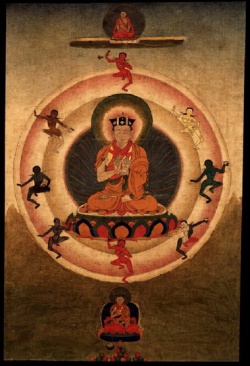Difference between revisions of "(Bodhisattva)"
(Created page with "<nomobile>{{DisplayImages|741|801}}</nomobile> bodhisattva (S): Tibetan: Jang-chub sempa. Awakened Being. Shakyamuni Buddha used this term to describe himself...") |
|||
| (One intermediate revision by the same user not shown) | |||
| Line 1: | Line 1: | ||
| − | + | {{DisplayImages|682}} | |
| − | bodhisattva (S): Tibetan: [[Jang-chub sempa]]. Awakened Being. Shakyamuni Buddha used this term to describe himself when he was seeking enlightenment. | + | [[bodhisattva]] (S): [[Tibetan]]: [[Jang-chub sempa]]. [[Awakened]] Being. [[Shakyamuni Buddha]] used this term to describe himself when he was seeking [[enlightenment]]. |
| − | Bodhi means "Enlightenment" and sattva means "sentient" or "conscious. | + | [[Bodhi]] means "[[Enlightenment]]" and [[sattva]] means "[[sentient]]" or "[[conscious]]. |
| − | Thus "bodhisattva" refers to a "sentient | + | Thus "[[bodhisattva]]" refers to a "[[sentient being]] of [[great wisdom]] and [[enlightenment]]." The [[bodhisattva's]] goal is the pursuit of [[Buddhahood]] and the {{Wiki|salvation}} of all. The [[bodhisattva]] cycles through [[rebirths]] to help {{Wiki|liberate}} [[beings]] from [[suffering]] and further establish the [[Dharma]] in the [[world]]. |
| − | The bodhisattva path and discipline, generally accepted by Mahayana practitioners, is based in the aspiration, generation and application of the bodhicitta. | + | The [[bodhisattva path]] and [[discipline]], generally accepted by [[Mahayana]] practitioners, is based in the [[aspiration]], generation and application of the [[bodhicitta]]. |
| − | Bodhisattvas are awakening beings whose realization is not yet that of the Buddhas. | + | [[Bodhisattvas]] are [[awakening]] [[beings]] whose [[realization]] is not yet that of the [[Buddhas]]. |
| − | The bodhisattvas develop the intention to reach the state of Buddha, in order to release all sentient beings from the suffering of the cycle of existence. | + | The [[bodhisattvas]] develop the [[intention]] to reach the [[state]] of [[Buddha]], in order to [[release]] all [[sentient beings]] from the [[suffering]] of the [[cycle of existence]]. |
| − | They work with this intention while developing compassion and renouncing the stain of any personal interest. | + | They work with this [[intention]] while developing [[compassion]] and renouncing the stain of any personal [[interest]]. |
| − | Accompanied by Joyful effort and the other paramitas, this altruistic attitude permits one to slice through the thick inertia of egocentric habit energy and constitutes the energy of awakening. | + | Accompanied by [[Joyful]] [[effort]] and the other [[paramitas]], this {{Wiki|altruistic}} [[attitude]] permits one to slice through the thick {{Wiki|inertia}} of [[egocentric]] [[Wikipedia:Habit (psychology)|habit]] [[energy]] and constitutes the [[energy]] of [[awakening]]. |
| − | The bodhisattva works for the good of beings until the end of samsara through the practice of the ten | + | The [[bodhisattva]] works for the good of [[beings]] until the end of [[samsara]] through the practice of the [[ten perfections]] - or [[paramitas]]. There are [[ten stages]] in the [[Bodhisattva]] process. |
| − | A Mahasattva is one who has reached the tenth stage but delays entering complete Enlightenment so as to help others. | + | A [[Mahasattva]] is one who has reached the tenth stage but delays entering [[complete Enlightenment]] so as to help others. |
| − | See bhumi; Four Great Vows. | + | See [[bhumi]]; [[Four Great Vows]]. |
{{R}} | {{R}} | ||
http://docslide.us/documents/tantric-glossary.html | http://docslide.us/documents/tantric-glossary.html | ||
[[Category:Bodhisattva's]] | [[Category:Bodhisattva's]] | ||
Latest revision as of 01:01, 9 November 2015
bodhisattva (S): Tibetan: Jang-chub sempa. Awakened Being. Shakyamuni Buddha used this term to describe himself when he was seeking enlightenment.
Bodhi means "Enlightenment" and sattva means "sentient" or "conscious.
Thus "bodhisattva" refers to a "sentient being of great wisdom and enlightenment." The bodhisattva's goal is the pursuit of Buddhahood and the salvation of all. The bodhisattva cycles through rebirths to help liberate beings from suffering and further establish the Dharma in the world.
The bodhisattva path and discipline, generally accepted by Mahayana practitioners, is based in the aspiration, generation and application of the bodhicitta.
Bodhisattvas are awakening beings whose realization is not yet that of the Buddhas.
The bodhisattvas develop the intention to reach the state of Buddha, in order to release all sentient beings from the suffering of the cycle of existence.
They work with this intention while developing compassion and renouncing the stain of any personal interest.
Accompanied by Joyful effort and the other paramitas, this altruistic attitude permits one to slice through the thick inertia of egocentric habit energy and constitutes the energy of awakening.
The bodhisattva works for the good of beings until the end of samsara through the practice of the ten perfections - or paramitas. There are ten stages in the Bodhisattva process.
A Mahasattva is one who has reached the tenth stage but delays entering complete Enlightenment so as to help others.
See bhumi; Four Great Vows.
